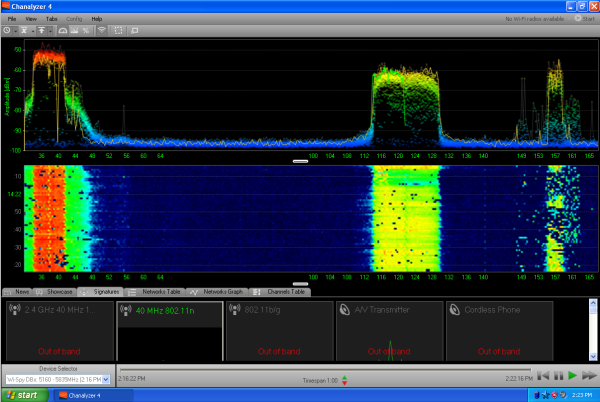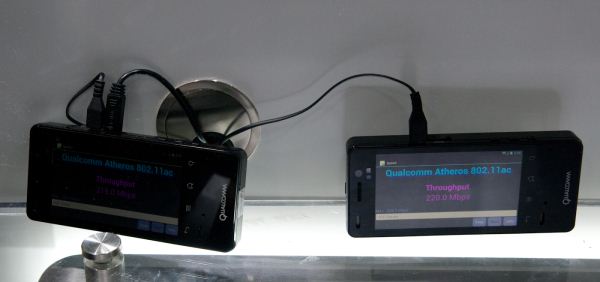Qualcomm Atheros Demos 802.11ac on MSM8960
by Brian Klug on February 27, 2012 4:01 PM ESTAmong a bunch of interesting Krait features is a noteworthy change in connectivity that represents some of the first fruits of the Qualcomm Atheros acquisition. We touched on it in our architecture piece a while back, but that feature is inclusion of the WiFi and Bluetooth 4.0 basebands into Krait alongside the traditional combination of cellular and GPS baseband.
Just like cellular is implemented today, that design still requires external RF, but the result is a WLAN and Bluetooth baseband that get to take advantage of the SoC's 28nm process geometry. Today I caught a glimpse of both 802.11n single spatial stream, and more interestingly 802.11ac single spatial stream running on an MDP MSM8960 utilizing the on-SoC WiFi basebands and the corresponding WCN3680 external RF chip.
The demo itself was pretty self explanatory - Qualcomm was running an 802.11ac network with two MDP MSM8960s and seeing throughput of around 220-230 Mbps using their single spatial stream WCN3680 external RF. This was live on the crowded MWC show floor with other 5 GHz APs running nearby, and admittedly pretty brave to do considering other 802.11ac demos I saw at CES used wired links. The end result is pretty impressive, and it'll be interesting to see how many of OEMs choose to go this route for WiFi, Bluetooth and FM Rx/Tx (also inside WCN3680) as opposed to some of the more common discrete solutions. In addition Qualcomm had an 802.11n demo showing the same functionality.

The 802.11ac network is the middle, 80 MHz wide one in the middle, between channels 112 and 132
Just like I did at CES with Buffalo's AP demo, I also had the WiSpy DBx handy and captured another sample of the 80 MHz OFDM waveform, just to take another peak.
Update: Replaced incorrect WCN3860 name with WCN3680 name reflecting June 4, 2012 announcement.
Additional: Qualcomm Atheros











6 Comments
View All Comments
aNYthing24 - Monday, February 27, 2012 - link
Qualcomm is killing it this year.retrospooty - Monday, February 27, 2012 - link
I know... freegin drool!!!I can see one of these newer 28nm puppies (not necesarily with 802.11ac) on a Nexus S2 class phone 4.65 inch 1280x720 screen, 4G, with a long lasting removable battery, and still thin. A few more months.
apinkel - Monday, February 27, 2012 - link
Yeah, the msm8960 previewed really has me interested in the krait SOCs and their unparallelled integration coupled with the move to 28nm... that all sounds great... but...I'll be very interested in how well the real-world battery life is on some of these new S4 based phones... I really like the new HTC One X, the form factor the feature set, the performance... but that better be one efficient SOC since the One X has a medium sized non-user-replaceable battery.
Arbie - Tuesday, February 28, 2012 - link
Which peak are you going to take?name99 - Tuesday, February 28, 2012 - link
"The end result is pretty impressive, and it'll be interesting to see how many of OEMs choose to go this route for WiFi, Bluetooth and FM Rx/Tx (also inside WCN3860) as opposed to some of the more common discrete solutions."How is a 250Mbps PHY impressive in this situation? Yeah, they got it to work, but that's the least one expects if they're demoing in public.
Single stream 40MHz 802.11n has a max PHY rate of 150Mbps. Ramp that to 80MHz and you're at at least 300. But you should be a few percent better because you use slightly more than twice the subcarriers for 80 rather than 40. Throw in 256QAM and you should gain another 30%.
Rather than "impressive" this looks like "we got the bare minimum working" - no 256QAM, no short guard interval, maybe even the 64QAM FEC isn't yet ramped up to maximum throughput. Do they even have LDPC running yet? Do the have PHY level aggregation? Do they have a MAC that is more advanced than WMM and the start of the art in 2005?
People (and this goes especially for journalists) are WAY too easy on tech companies in this space. You should be learning what the optional parts of the spec are, and grilling companies about when they will be supporting them, not grinning slackjawed at "oohh, them's mighty big numbers".
I don't want to a prick about this, but it really is irritating. AnandTech is about the premier blogging site for this stuff, but even they couldn't seem to be bothered to actually care about the tech beyond adolescent-boy-like fawning over something new because it's new.
sjt2 - Monday, May 14, 2012 - link
It sure is impressive, IMHO integration of WiFi with the application processor along with GSM/GPRS/EDGE/HSPA/LTE, GPS, Bluetooth, FM all inside one single chip is definitely impressive..